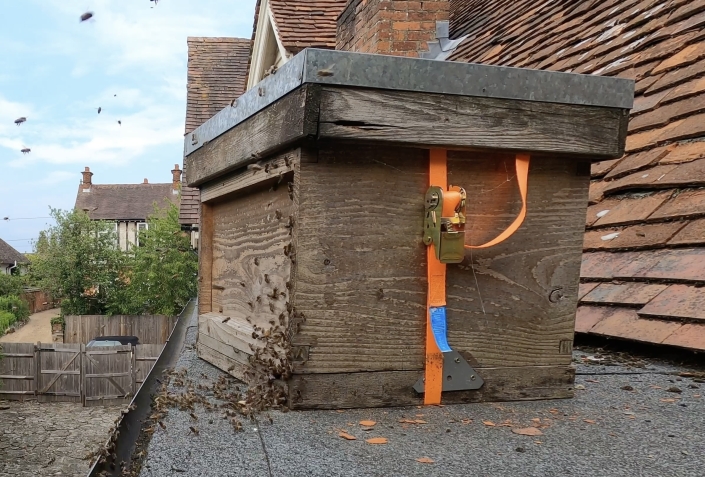For the past 5 years I have been using a bait hive with reasonable success, catching a swarm in 4 out of 5 years. In fact last year I picked up a swarm from one of my own hives that I hadn’t managed properly. I haven’t changed much in the way I set the hive up other than starting earlier in the season than I used to – now I put it up beginning of May about 4 metres off the ground with the entrance facing in a westerly direction. It’s in a sheltered position and doesn’t receive full sun for more than a couple of hours a day. My own hives are about 40 metres away and I think that there are about 4 other beekeepers within a 2 mile radius.
The hive I use is a normal brood box with a roof but no coverboard. Apparently when bees are searching for a new home they look for a space that’s similar in size to a brood box, something with a volume of around 36l. The main difference is the floor is similar to a swarm box, solid with a reduced entrance 40mm wide positioned close to one of the sides, i.e. not central. The floor is screwed to the brood box using a couple of small angle plates to make it easier to transport. The whole hive is then strapped up with a ratchet strap which makes it easier to manoeuvre.
To “bait” the hive it’s important to make it appealing to the scout bees and I insert 4 old brood frames, ideally with no stores. The older the better seems to be best. As an attractant I then smear some lemon oil across the top of the frames and put some on a kitchen towel which I put in a plastic bag loosely scrunched up – keeps the lemon oil from evaporating too quickly.
The tricky part for me is getting the bait hive up and down the ladder as it’s relatively bulky. So I use a long ladder set at a gentle slope which makes it a bit easier than a steep angle. Once in position I open the hive up to make sure the frames are orientated correctly and push them to the side furthest from the entrance. I’ve learnt from experience that the Bees seem to prefer this. When I started using a bait hive I placed combs centrally and found that they ignored them and drew brace comb as far from the entrance as possible. Then I strap the hive back up so that I’m not having to mess around when there is a swarm in place.
Once the hive is in position you need to check every couple of days for activity around the hive. Quite often you you will see scout Bees checking the hive out but it won’t be until you have got a constant stream of bees going to and from the hive that you will know if you have captured a swarm. It’s not critical to move the hive as soon as you get lucky but ideally within a few days, especially if it’s a large one with an already mated Queen because they will run out of space quickly. Again like a swarm move it late evening when the foragers have stopped flying.
Treat it like a normal swarm, feeding it with syrup if there isn’t a strong flow on. Inspect after about a week and if needed swap onto a mesh floor and add additional brood frames.


